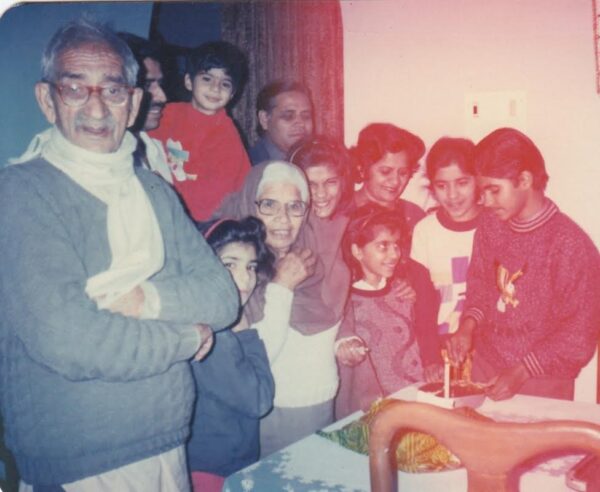TEXT AND PHOTOGRAPHS BY AMIT JULKA
Singapore

Sometime in 1937, the baraat of a twenty-year-old Kasturilal Julka landed on the doorstep of a fourteen year old Rajkumari Duggal, who lived in the village of Daulatanagar, situated in Gujrat district of a still Undivided Punjab. The young Kasturilal belonged to a family of shahs (moneylenders) from a village named Bhlorpur (Behlolpur), situated on the banks of the Chenab. Raised, and mostly spoilt by his mother Veeranwali, Kasturilal grew up in a house without a dominant male figure, as both his father Khazan Chand and grandfather Gujjar Shah had passed away at early ages. Thus, being an only child and most importantly, the surviving male heir, his marriage was an occasion of much fanfare and celebration, a chance for the family to transcend the tragedies that had befallen it.

Commensurate with the importance of the occasion therefore, was the attention paid to the various ritual objects of the wedding ceremony. One such object was the silver mukut, a crown which was part of my grandfather’s sehra (the bridegroom’s floral veil). The mukut, like most of the wedding’s accessories, was crafted in Lahore. It consists of five panels bearing the images of the Hindu deities Brahma, Durga, Ganesh, Vishnu and Shiva respectively. Embossed below the deities are images of the vaahan (vehicle) of each deity, namely Brahma’s hans (swan), Durga’s sinh (tiger), Ganesh’s moosa (mouse), Vishnu’s garud (mythical bird) and Shiva’s nandi (bull). Above each deity is an ornate floral pattern with what appears to be the image of surya, the sun god. The five panels are connected through hinges with a silver trim dangling at the bottom. There are two small hoops on the either side to tie the mukut to the sehra. While there was an old thread for this purpose, it has since frayed and been replaced.
Along with the mukut, my grandfather also had his fiancée, my grandmother’s trousseau especially stitched from Anarkali Bazar in the grand city of Lahore. The trousseau consisted of a rich maroon velvet shalwar qameez intricately embroidered with threads of sucha sona, pure gold. To understand the significance of this, it is important to understand the prestige of the Anarkali bazar. If Lahore was the beating heart of Punjab, Anarkali was the dil-o jigar of Lahore. To make an old world, Delhi-specific analogy, it was Chandni Chowk and Connaught Place rolled into one, a place that defined high fashion (not to mention great food), thus living up to the Punjabi ideal of changa khaana te changa paana or “Eat well, dress flamboyantly!”
When the partition of British India took place ten years later in 1947, my grandmother Rajkumari was at her maternal house. Facing the prospect of imminent violence, but also harbouring within his heart a glimmer of hope that ‘things would soon be fine’, my grandfather left Bhlorpur on a horse, taking only a few objects with him. Among these were the mukut and my grandmother’s shalwar qameez from her trousseau. Another heirloom that he carried was my great grandfather’s silver hukka, which he himself used quite often. My father recollects fondly the elaborate process of lighting the coal and inserting the tobacco. But that’s a story for another time.
Over the last 83 years, both these wedding heirlooms have remarkably withstood the test of time. The mukut, in fact, has adorned the sehra of three grooms, gleaming brightly at my grandfather’s wedding in 1937, carrying his legacy onto my father’s forehead in 1978, and finally connecting their stories to mine in 2019. Those five silver plates have witnessed countless stories of lives cast asunder by the tumultuous passage of time, but a gentle scrubbing was always enough to reveal the mysteries of filial heritage long considered lost to material decay. The crown had felt heavy when I placed it on my head, but perhaps what I truly felt was the weight of the memories of three generations.
A few days after my wedding, my cousin got married as well, and just like the mukut, the shalwar kameez returned, 82 years after it was first adorned by my dadi, carrying forth her legacy and memory by my sister-in-law on her wedding day. It doesn’t look a day older than that first day in 1937, when an excited lad of twenty must have picked it up from the darzi at Anarkali bazaar, wondering what lay ahead. The future did not shape up the way young Kasturilal would have predicted. History soon proved to be both a tragedy and a farce, where grand ideologies and lawyers with pencils uprooted people and their little dreams. However, across decades, barbed wires and the finiteness of life itself, these inanimate objects became repositories of stories of those who once held them. For us, they are the sutradhars — connecting our threads with an otherwise remote and inaccessible past and it is in these shared memories of cultural rootedness that we can hope to find individual and social catharsis.





It looks like a quick read, but your essay is anything but that for folks like myself. Folks like us. My Dadaji, Paiji (grandfather & great-grandfather) – with 100 of my ancestral kin left west Punjab (Rawalpindi/Lyallpur) to settle in Delhi in 1947, where my parents, and their children were born. My grandparents never spoke of ’47 or of ’84, yet here I am trying to reminisce memories, and create sutradhars that they would have passed down to us. I am equal parts grateful and jealous of your post, but with a greater desire to read more of what you have.
Your story is similar to my grandparent’s story..they came from Rawalpindi carrying only some jewellery and out of which is a mukut..